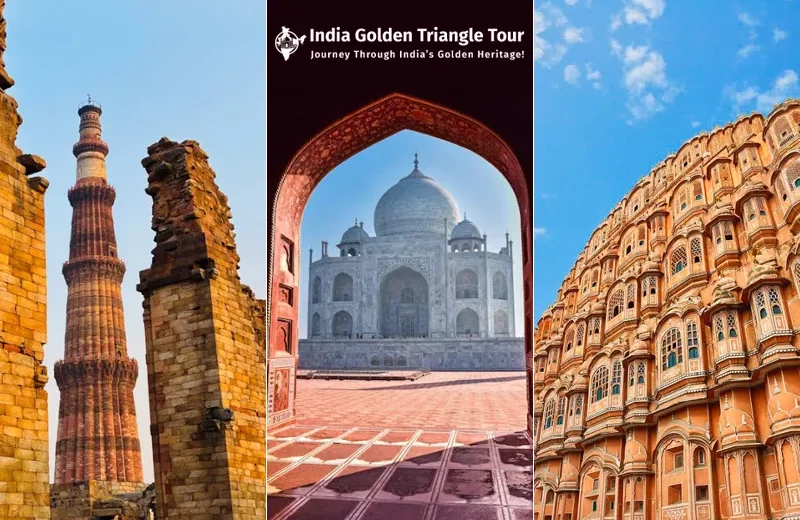This travel guide will take you through India’s Golden Triangle, an ideal gateway into the country’s incredible diversity and rich heritage.
Besides being one of India’s most popular and well-traveled tourist circuits, it connects Delhi, Agra, and Jaipur. Each city offers its own unique charm, history, and culture. Let’s discover what makes India’s Golden Triangle such an unforgettable journey for travelers from around the world.
What is the Golden Triangle?
The Golden Triangle is one of India’s most popular and rewarding travel routes, especially for first-time visitors. The route gets its name from the triangular shape formed on the map by three iconic northern cities: Delhi, Agra, and Jaipur.
Each city in the Golden Triangle offers something different pertaining to India’s history, culture, and tradition. Delhi, being the national capital, is gracefully crowned with both old and new, starting from ancient monuments down to modern city life, complete with mouthwatering street food. Agra entices visitors with its world-famous Taj Mahal among other remarkable Mughal era masterpieces. On the other hand, Jaipur—the Pink City—takes travelers into the realm of royal palaces, great forts, and colorful bazaars filled with handicrafts and textiles.
Together, these cities create the perfect introduction to India’s incredible diversity and timeless charm.
Why Tour the Golden Triangle?
India is an amazingly diverse country, with every different region offering something different in its geography, culture, food, and way of living. For the first-time visitor, knowing where to start can be pretty daunting. That’s where the Golden Triangle Tour comes in: the perfect introduction to India, offering a great mix of history, architecture, and culture within a short time.
This short but rewarding trip gives ample time to visit some of India’s famous cities without any sense of haste. Each city has a tale to say, whether it be Delhi with its energetic amalgamation of ancient heritage and modern charm, Agra with Mughal splendor that is timeless, or Jaipur with its royal forts and colorful bazaars. The journey appears to epitomize the essence of India within only a few days.
It’s also an excellent route for solo travelers because the cities are well-connected, safe, and always buzzing with fellow tourists. From budget to luxury travel, the Golden Triangle has endless options for transport, stay, and sightseeing to make every kind of traveler very comfortable and flexible.
And if you have a little extra time, this itinerary can easily be extended to include other destinations like Pushkar, Ranthambore, Varanasi, or Udaipur for an even deeper Indian experience.
Guide to India’s Golden Triangle
Here’s everything you need to know about the three incredible cities that make up India’s famous Golden Triangle—Delhi, Agra, and Jaipur.

Delhi – Vibrant Heart of India
Most tours to the Golden Triangle begin in Delhi, the bustling capital and generally considered the gateway to India. It has good international flights to all major cities and is where your Indian adventure will really begin.
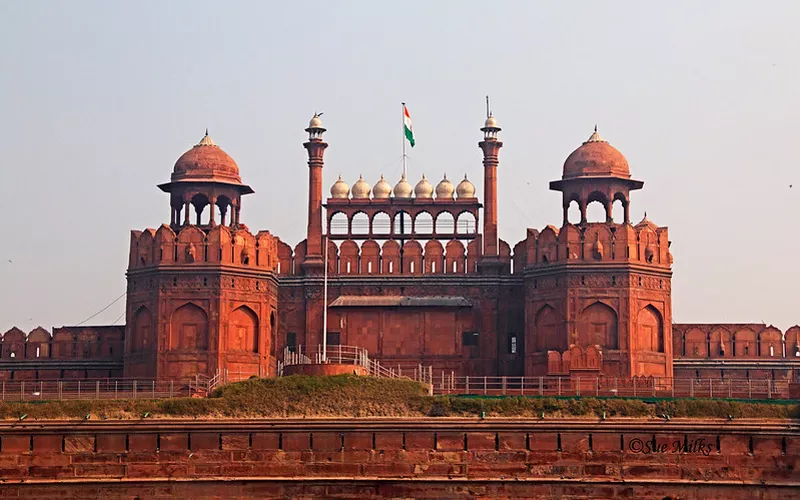
A city where ancient history meets modern energy, Delhi offers two different worlds—the grandeur of New Delhi and the old-world charm of Old Delhi. The broad, tree-lined avenues and colonial architecture that mark New Delhi form a striking contrast to the narrow, bustling streets and ancient bazaars of Old Delhi.
Take leisurely strolls along Rajpath, admire the imposing India Gate, and see the stately Rashtrapati Bhavan, the President’s residence in New Delhi. The world’s oldest astronomical observatory, Jantar Mantar, the architectural elegance of Humayun’s Tomb, which inspired the Taj Mahal—nothing should be missed here, nor the soaring UNESCO World Heritage Site that reflects the rich past at Qutab Minar.
Then, step into the chaos and charm of Old Delhi. Explore Chandni Chowk, a maze of spice markets, street food stalls, and vibrant shops—a haven for food lovers and culture enthusiasts alike. Visit the majestic Jama Masjid, one of India’s largest mosques, towering over the old city with timeless grace. And last but not least, there is the Red Fort, made of red sandstone during the Mughal era, which stands elegantly. Within its walls are the Diwan-i-Khas or the Hall of Private Audience, Diwan-i-Aam or the Hall of Public Audience, and Rang Mahal or the Palace of Colors, each whispering stories of the royal splurge and history.
Agra – The Timeless City of Love
No journey to India is complete without witnessing the breathtaking beauty of the Taj Mahal. Standing gracefully on the banks of the Yamuna River, this white marble masterpiece has been a global symbol of love and devotion for centuries. Commissioned by Mughal Emperor Shah Jahan in memory of his beloved wife, Mumtaz Mahal, the Taj Mahal continues to attract millions of visitors from around the world each year.
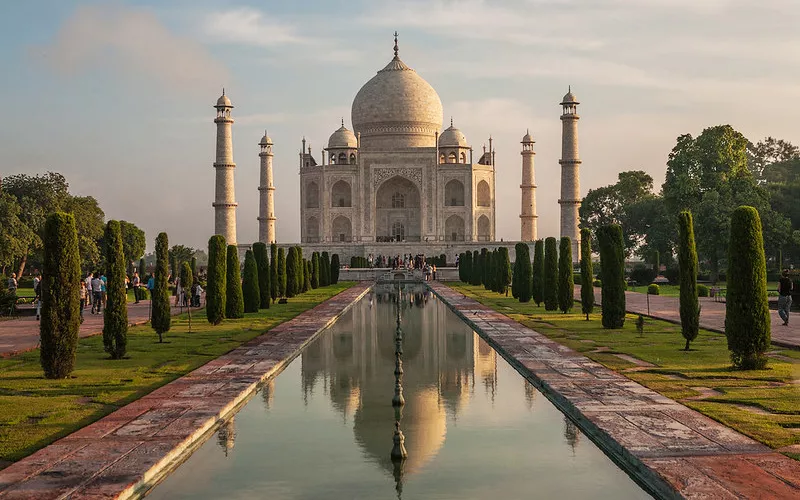
Traveling from Delhi to Agra is quick and convenient — about a four-hour drive via the Yamuna Expressway, or less than two hours by train on the Gatimaan Express, India’s fastest train.
Seeing the Taj Mahal in person is a moment that words can hardly capture. Its flawless symmetry, intricate carvings, and the soft glow of sunlight on its marble surface make it one of the most awe-inspiring sights in the world. While most visitors come at sunrise to admire its golden hues, seeing the Taj Mahal under the moonlight is an equally magical experience. On select nights around the full moon, a limited number of visitors are allowed entry to witness its ethereal beauty shining in silver tones.
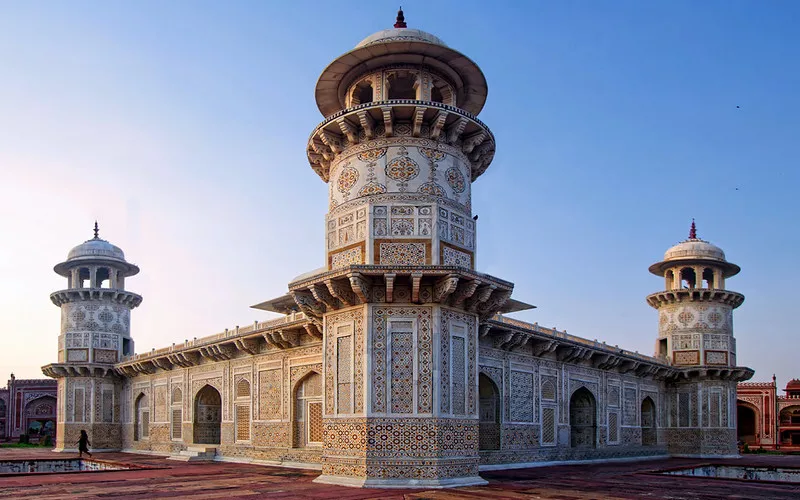
Beyond the Taj Mahal, Agra offers a wealth of historical treasures. Visit the impressive Agra Fort, another UNESCO World Heritage Site, where Mughal emperors once lived and ruled. Within its red sandstone walls, explore magnificent halls like the Sheesh Mahal (Palace of Mirrors) and the Diwan-i-Khas (Hall of Private Audience). Don’t miss the elegant I’timad-ud-Daulah, often called the Baby Taj, known for its intricate marble inlay work that inspired later Mughal architecture.
A short drive from the city lies the fascinating Fatehpur Sikri, a perfectly preserved Mughal city and UNESCO World Heritage Site. Built by Emperor Akbar in 1569 as his imperial capital, it was later abandoned due to water shortages. Today, its grand gateways, palaces, and courtyards remain frozen in time — a hauntingly beautiful reminder of India’s royal past.
Jaipur – The Pink City of Royal Splendor
Welcome to Jaipur, the dazzling capital of Rajasthan, famously known as the Pink City. With its grand forts, ornate palaces, and vibrant markets, Jaipur beautifully captures the royal essence of India and showcases the brilliance of Rajasthani architecture at every turn.
At the heart of the city stands the magnificent Hawa Mahal, or Palace of Winds — a five-story masterpiece made of pink sandstone, featuring hundreds of intricately carved windows. Built for the royal women to observe street festivals unseen, this iconic structure remains one of Jaipur’s most photographed landmarks.
Often called the “City of Forts,” Jaipur is home to the majestic Amber Fort (Amer Fort), perched on a hill overlooking Maota Lake. Its massive walls, said to be second in length only to the Great Wall of China, enclose stunning courtyards and palaces that reflect the splendor of Rajput craftsmanship.

Another highlight is the City Palace, where Jaipur’s royal family still resides. Part of the complex has been converted into a fascinating museum that displays royal artifacts, weapons, and textiles — offering a glimpse into the city’s regal heritage. Nearby stands Jantar Mantar, a UNESCO World Heritage Site and astronomical observatory built by Maharaja Jai Singh II, featuring enormous instruments that once measured time and celestial movements with astonishing accuracy.
Jaipur’s charm extends beyond its monuments. Visit Nahargarh Fort for panoramic views of the city, Jaigarh Fort for its historical cannons, and Jal Mahal, a beautiful palace floating on the waters of Man Sagar Lake. For a spiritual touch, don’t miss the Birla Temple or the Monkey Temple (Galta Ji), both serene and culturally rich spots.
No trip to Jaipur is complete without exploring its bustling bazaars. From colorful textiles like block prints and bandhej, to handcrafted jewelry, gemstones, blue pottery, and rugs, the city’s markets are a paradise for shoppers and souvenir seekers alike.
Whether you’re a history lover, architecture enthusiast, or simply drawn to vibrant culture, Jaipur promises a royal experience that lingers long after your visit.
Make It a Grand Circuit: Add More Stops to Your Journey
If you’ve got a few more days to spare, why stop at just Delhi, Agra, and Jaipur? Extending your Golden Triangle tour gives you the chance to experience even more of India’s incredible diversity — from spiritual towns and royal cities to wildlife adventures and serene lakes.
Rishikesh – The Spiritual Escape
Head north from Delhi to Rishikesh, known around the world as the Yoga Capital of India. Nestled in the foothills of the Himalayas and set along the sacred Ganges River, Rishikesh is a haven for yoga lovers, spiritual seekers, and nature enthusiasts. Join a yoga class by the river, witness the enchanting Ganga Aarti at Triveni Ghat, or simply unwind and soak in the peaceful mountain atmosphere before continuing toward Agra and Jaipur.
Varanasi – The Soul of India
For a deeper spiritual experience, include Varanasi, one of the world’s oldest living cities and the spiritual heart of Hinduism. Located on the banks of the Ganges, this sacred city offers a window into India’s timeless traditions. Watch the breathtaking morning and evening aartis at the ghats, wander through ancient alleys filled with temples, and visit the revered Kashi Vishwanath Temple. You can easily fly from Delhi to Varanasi, then continue your Golden Triangle journey to Agra.
Ranthambore – The Wild Side of Rajasthan
Nature lovers will find their paradise in Ranthambore National Park, located between Agra and Jaipur. Once a royal hunting ground, it’s now one of India’s best spots to see Bengal tigers in the wild. The park’s landscapes are dotted with ancient ruins and lakes, and high above it all stands the Ranthambore Fort, a 10th-century fortress offering spectacular views across the jungle.
Udaipur – The City of Lakes
For a touch of romance, add Udaipur to your itinerary — a city often called the most beautiful in India. Set against the backdrop of the Aravalli Hills and built around the shimmering Lake Pichola, Udaipur is filled with graceful palaces, narrow lanes, and serene spots for sunset boat rides. Visit the magnificent City Palace, explore Jag Mandir Island Palace, or simply relax by the lakeside and take in the city’s old-world charm.
Pushkar & Jodhpur – The Spirit of Rajasthan
End your extended journey in Pushkar, a sacred desert town known for its Brahma Temple and the world-famous Camel Fair. From there, continue to Jodhpur, the majestic Blue City. Dominated by the towering Mehrangarh Fort, Jodhpur offers sweeping views of cobalt-blue homes and a rich tapestry of Rajasthani life. As you travel through this region, you’ll witness the vibrant colors, rustic landscapes, and warm hospitality that define rural Rajasthan.
Whether you’re in search of spiritual peace, royal grandeur, or wild adventure, extending your Golden Triangle tour adds new dimensions to your journey — turning a great trip into an unforgettable Indian experience.
How to Travel Between Delhi, Agra, and Jaipur
Traveling through the Golden Triangle — Delhi, Agra, and Jaipur — isn’t just convenient; it’s an experience in itself. Every stretch of the journey reveals a new side of India — from Delhi’s buzzing city life to Agra’s Mughal elegance and Jaipur’s regal Rajasthani charm.
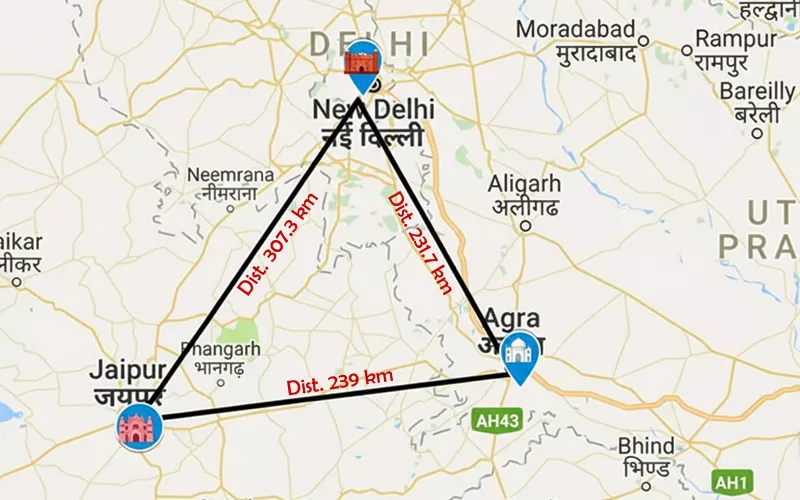
The most popular and scenic way to explore the route is by road. Thanks to well-maintained highways like the Yamuna Expressway and NH 48, road trips between these cities are smooth and enjoyable. Traveling by private car or on a guided tour gives you the freedom to stop whenever something catches your eye — maybe to sip a hot cup of chai at a roadside stall, wander through a local village, or capture the vibrant landscapes that unfold along the way.
If you prefer speed and comfort, India’s train network is an excellent option. The Gatimaan Express connects Delhi and Agra in under two hours, while the Shatabdi Express and Vande Bharat Express make traveling between all three cities fast, easy, and comfortable.
Short on time? Regular flights between Delhi and Jaipur cut down travel time to under an hour, letting you make the most of your stay.
No matter how you choose to travel, the true charm of the Golden Triangle lies in the journey itself — in the colorful roadside scenes, the friendly locals, and those small, unexpected moments that turn a simple trip into a story you’ll never forget.
What to Look for in Your Accommodation
Choosing the right place to stay can make all the difference in your Golden Triangle experience. Whether you’re looking for royal luxury or a cozy hideaway, here are a few key things to keep in mind:
Location & Access:
Pick a hotel that suits your itinerary — close to major attractions, transport hubs, or the city center, depending on your travel plans. Staying near train stations or expressway exits can be especially helpful if you have early departures.
Style & Vibe:
From restored havelis and heritage palaces to sleek modern hotels, choose accommodation that matches your travel style. If you love culture and charm, go for a traditional stay; if comfort and convenience are top priorities, a modern property might be perfect.
Comfort & Amenities:
Look for must-haves like air-conditioning, Wi-Fi, and breakfast options — essential during India’s varying seasons. A pool or spa can be a welcome bonus for unwinding after a long sightseeing day.
Value & Budget:
The Golden Triangle offers something for every budget. Prices can vary widely, so booking in advance can help you secure great value for your stay.
Suggested Hotels Along the Route
Delhi
- For Luxury: The Imperial New Delhi — An iconic heritage-style hotel in central Delhi that blends colonial grandeur with modern comfort.
- For Boutique Charm: Haveli Dharampura — A beautifully restored 200-year-old haveli in Old Delhi, perfect if you want something intimate and full of character.
Travel Tip:
If you’re arriving early or departing late, consider a hotel in a quieter neighborhood — Delhi traffic can be unpredictable.
Agra
- Top Luxury: The Oberoi Amarvilas — Just 600 meters from the Taj Mahal, offering uninterrupted views of this world wonder from most rooms.
- Premium Value: ITC Mughal, a Luxury Collection Resort & Spa — Set amidst lush gardens, this resort combines Mughal-inspired design with modern indulgence.
- Mid-Luxury Comfort: Trident, Agra — Known for its warm service, beautiful landscaping, and excellent value for the price.
Travel Tip:
For a peaceful sunrise visit to the Taj Mahal, stay close to the monument — it’ll make your early start much easier.
Jaipur
- High-End Heritage: The Oberoi Rajvilas — A luxurious resort offering royal-style villas and tranquil gardens just outside the city bustle.
- Classic Palace Stay: Raj Palace Hotel — A restored royal palace with lavish interiors, perfect for travelers wanting the full “royal India” experience.
Travel Tip:
Choose accommodation that offers a balance between access to Jaipur’s Old City (for bazaars and landmarks) and easy routes to your next destination.
Best Time to Visit the Golden Triangle
The Golden Triangle — covering Delhi, Agra, and Jaipur — is best explored between October and March, when the weather is at its most comfortable. During these months, you’ll enjoy clear skies, cooler temperatures, and ideal conditions for sightseeing, outdoor excursions, and photography.
In January and February, Delhi can get quite chilly, and Agra often wakes up under a soft blanket of morning fog. Still, these winter months bring a calm, cozy charm to your journey. The months of February, March, October, and November strike the perfect balance — warm days, crisp evenings, and a lively travel atmosphere. Keep in mind, however, that these are peak tourist months, so attractions can get crowded, and booking your hotels early is a smart move.
If you want to pair your trip with India’s cultural celebrations, visit during October or November to experience the sparkle of Diwali, the festival of lights, or in March for Holi, the exuberant festival of colors — both unforgettable cultural highlights.
Avoid traveling during the summer months (May and June), when temperatures can exceed 45°C (113°F), especially in Rajasthan’s desert regions. However, this season is perfect for wildlife enthusiasts, as Ranthambore National Park offers excellent chances to spot tigers gathering around water sources. Just remember to stay hydrated, wear light clothing, and apply sunscreen generously.
The monsoon season (July to September) brings scattered rainfall to northern India. While the Golden Triangle doesn’t experience heavy downpours like southern India, occasional showers and humidity can slow down travel plans. Also note that Ranthambore National Park remains closed during the monsoon.
To sum up, the best time to visit the Golden Triangle is from October to March, when pleasant weather, festive energy, and rich cultural experiences come together to create an unforgettable journey through India’s heartland.
Essential Tips for Visiting the Golden Triangle
Traveling through India’s Golden Triangle — Delhi, Agra, and Jaipur — is an incredible journey filled with color, culture, and history at every turn. To help you make the most of your trip, here are some essential travel tips for a safe, comfortable, and memorable experience:
- Stay Alert and Keep Your Belongings Safe
The streets and markets of India are vibrant and lively — part of the charm, but also a place to stay mindful. Keep your valuables secure, avoid displaying expensive items, and stay aware of your surroundings, especially in crowded areas. - Watch Out for Scams
While most locals are warm and welcoming, it’s best to be cautious of overly persistent hawkers or people offering unsolicited help. Politely decline any suspicious offers for “special tours” or “exclusive deals,” and avoid giving money to strangers asking for donations. - Hire a Knowledgeable Local Guide
A licensed local tour guide can bring India’s monuments and culture to life. Many guides speak fluent English and share fascinating stories and facts that you might miss on your own — turning a simple visit into an enriching experience. - Dress Modestly and Comfortably
Respect local customs, especially at temples, mosques, and heritage sites. Choose modest clothing that covers your shoulders and knees. Light, breathable fabrics are best for daytime sightseeing, while a scarf or shawl is useful when visiting religious places. - Pack Smart for the Season
India’s weather varies across the year, so pack accordingly:
– Summer (April–June): Light cotton clothes, sunscreen, hats, and sunglasses are must-haves.
– Monsoon (July–September): Carry a raincoat, umbrella, and waterproof shoes.
– Winter (October–February): Bring warm layers for cool evenings, especially in Delhi and Agra. - Drink Safe, Bottled Water
Always choose sealed bottled water from trusted brands like Bisleri or Kinley, and avoid tap water. Staying hydrated is important — just make sure it’s from a reliable source. - Enjoy Street Food Wisely
Indian street food is irresistible — spicy, flavorful, and full of character! But to avoid “Delhi belly,” eat only freshly cooked dishes served hot, and skip raw or pre-cut fruits that have been sitting out. - Travel Smart at Night
If you’re a solo traveler, especially a woman, avoid walking alone after dark. Opt for trusted cab services like Ola or Uber, or pre-book transfers through your hotel or tour operator. - Research Before You Go
Understanding the Golden Triangle’s highlights beforehand helps you plan your route efficiently and appreciate each destination’s history and culture on a deeper level.
At India Golden Triangle Tour, we handle all the planning — from transportation and accommodations to personalized itineraries — so you can focus on soaking up the beauty, flavor, and spirit of India.
Ready to Discover the Golden Triangle?
Whether you’re looking for a short cultural getaway or a leisurely exploration, we’ll design a journey tailored to your interests. Get in touch today, and let’s create your perfect Golden Triangle adventure!

